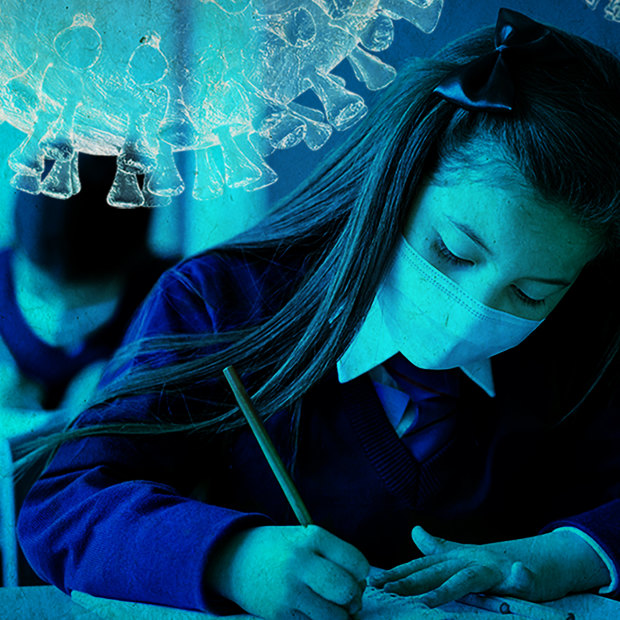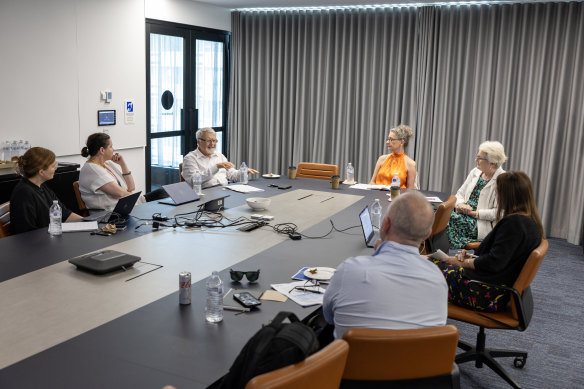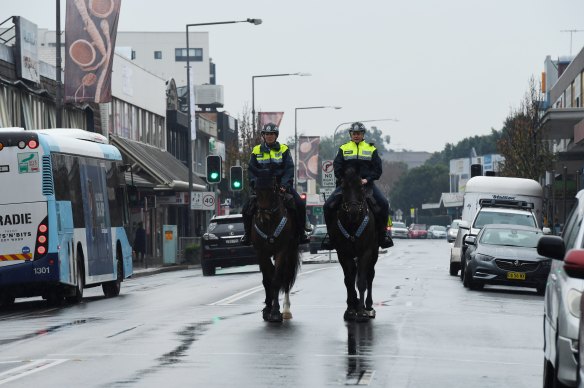This was published 8 months ago
Teenagers the biggest losers of COVID-era school closures
In the third and final part of this series, experts say the impact of COVID-era school closures on a generation of students is still unclear.
By Lucy Carroll and Jordan Baker

The Herald convened experts on education and child social development to discuss the impact of COVID policies on students.Credit: Matthew Absalom-Wong
Teenagers from disadvantaged backgrounds are still struggling to make up lost ground years after pandemic-era school closures, while experts warn the full impact of 1.2 million children missing out on months of in-person learning remains unclear.
The Sydney Morning Herald convened a panel of top educators to assess the impact of COVID-19 on students after the federal government failed to include the decision to close schools in its independent inquiry into how the nation managed the pandemic.
“It could take years before we see the full effect of closures, but for disadvantaged students it could impact their whole lives,” said Peter Shergold, a former top public servant and chair of the NSW Education Standards Authority.

The roundtable of experts discussed the ongoing impact of mass school closures during the pandemic.Credit: Dylan Coker
“I think COVID has set us back [in education] ... and the learning gaps are going to widen,” he said.
The panel included four education leaders and experts - Shergold, chief executive of the Australian Education Research Organisation, Jenny Donovan, chief executive of NSW Catholic Schools, Dallas McInerney, and the principal at Fairvale High School, Kathleen Seto.
Shergold said there is an obligation for governments to examine the social and educational damage as a result of school closures, which stretched for seven weeks in 2020 and more than three months in 2021.
The latest round of international testing shows the results of Australian teens held steady when compared with 2018; however, the entrenched achievement gap between rich and poor students continues to widen.
In the past two years, about 55 per cent of students in NSW have missed one day of school every fortnight, while the proportion of students dropping out of school has hit a ten-year-high. About 27 per cent of NSW students did not finish year 12 in 2022.
McInerney said that if confronted by another pandemic, “we should not upend the school environment like we did three years ago. We should do something very different.”
The COVID fallout: Education
This month marks four years since China’s COVID-19 outbreak was deemed a public health emergency of international concern, heralding the start of a traumatic period many of us would prefer to forget. While a federal government inquiry is examining some national responses to the crisis, key decisions made by states will not be properly scrutinised.
The Herald is concerned our political leaders have not adequately studied the lessons – good and bad – of our most recent experience, and we plan to ask tough questions over the coming months about the pandemic’s impact on education, health, border closures and lockdowns and policing. This is the final part of our three-part series looking at the impact of COVID on education. The forum discussions held in December with nine expert panellists were broken up into two sessions: one examining the wellbeing and behaviour of students, the second on academic and learning disruption.
Australian Education Research Organisation chief executive Jenny Donovan said high school students were among those most affected by school shutdowns, with early evidence from check-in assessments showing they fell three months behind in their learning.
“But we also have academic blind spots, too,” she said. “With the change in the way NAPLAN results are reported, cancelled assessments in 2020 and lower participation in national tests, it is difficult to know the extent children fell behind.”
Last year’s literacy and numeracy tests showed one in three NSW students are failing to read at the level expected for their grade. The way NAPLAN is reported changed in 2023, making comparisons with previous years difficult.
The latest PISA (Programme for International Student Assessment) report shows Australian teenagers from disadvantaged families lag their advantaged peers by five years of schooling, while Indigenous students are four years behind non-Indigenous students.
Donovan said the learning disruption has put a sharp spotlight on the scale of the learning gap, and the need to turn the tide on absenteeism and “ensure classrooms are well managed to strengthen the focus on learning”.
“Teachers can’t close gaps or improve the learning progress of students who aren’t there. Bad habits that emerged during the pandemic have become ingrained,” she said.
“We now see patterns of attendance where students don’t attend a day week, every week. It’s somehow become accepted by families. We’ve now got almost a sense that attendance is voluntary, non-compulsory, you don’t have to be there.”
Seto, whose school community in Fairfield West endured months of the harshest pandemic lockdowns, said the effects of remote learning are being felt heavily by her students entering their senior years.
“The kids who were in years 9 and 10 during the lockdowns, they’re the ones that are suffering the most. I see issues with coming late to school, not attending every day and our school has strong attendance data compared to similar schools,” she said.
“What I am also finding is students’ writing is not as extensive or as in-depth as it was a few years ago. They aren’t handing the teachers as many draft essays to read. So they’re the group that have suffered a lot in terms of their regulation, their writing skills, really all sorts of academic skills.”

Herald panellists (from left to right): Australian Education Research Organisation chief executive Jenny Donovan, Catholic Schools NSW chief executive officer Dallas McInerney, Fairvale High School principal Kathleen Seto and NSW Education Standards Authority chair Professor Peter Shergold. Credit: Dylan Coker
Many of them missed out on learning key algebra and maths concepts in-person which has a knock-on effect for students completing their HSC, Seto said.
“During the pandemic many of our students stopped school and went to work instead because their parents, many who were essential workers, would get sick and have to stay home. The [closures] exacerbated just how great the divide is,” she said.
Once regular in-person classes resumed, making sure students’ mobile phones were locked away during the day helped reset social engagement in the playground, Seto said. “Extracurricular sport and activities also boosted physical activity and being social with peers,” she said.
‘If confronted by the same circumstances in future, we should not upend the school environment like we did three years ago. We should do something very different.’
Dallas McInerney, CEO of Catholic Schools NSW
Shergold, who led a major independent review into the pandemic response, said unilateral decisions made by state governments to close entire school systems must be examined to improve government responses in future.
He warned that the Higher School Certificate is increasingly at risk of being sidelined in the post-COVID era as universities scramble to make early offers to students by bypassing ATARs.
“It’s just one of a whole series of educational consequences that you’re starting to see play out,” he said, including higher school drop-out rates.
His report published in late 2022, entitled Fault Lines, found people experiencing social inequalities bore the brunt of the pandemic.
“We started to use the shutdown of schools as if this was the key way to contain the virus, rather than ensuring the availability of vaccination, enhanced testing and high standards of school hygiene,” he said.
Taking students out of in-person classes was justified in the first months, but schools should have stayed open once more was known about the virus, Shergold said. Tough action, including closing schools, was judged politically popular by many state leaders, his report said.
Schoolchildren also missed a range of formative experiences, from formals to camps, graduations and gap years, the panellists said.
The panel agreed that overall NSW education systems were resilient during the pandemic, and schools responded well and rapidly to huge disruption. Teachers and school staff quickly adapted to online learning, and significant support was given to HSC students, especially those who went through the strictest lockdowns.

NSW Mounted Police patrolling the streets of Fairfield in Sydney’s south-west in July, 2021. Principal Kathleen Seto, whose school community in Fairfield West endured months of the harshest pandemic lockdowns, said the effects of remote learning are being felt heavily by her students entering their senior years.Credit: Kate Geraghty
“There was a fast response, especially for disadvantaged schools, with the distribution of laptops, rapid antigen tests, enhanced cleaning and vaccines,” Seto said.
However, a senate inquiry report into chaotic classrooms, released this month, said that between 2018 and 2022 the number of students who had disrupted learning because of teacher shortages grew. In PISA student surveys, more than 40 per cent reported noise and disorder in their maths classes most of the time, mirroring similar results in 2018.
McInerney said while attendance had rebounded in many schools there “is still the academic lag you’d expect ... especially for disadvantaged students, and for those who were the least attached to their schooling, there are persistent problems”.
“I don’t think we’re through the worst of it. So when these COVID kids move out of the education system they may take the lack of conditioning into other environments,” he said.
Donovan believes some of the persistent low-level disruption in classrooms is one knock-on effect of school closures.
“Children forgot how to behave. Those getting expelled from school or who are violent, that’s a rarer and bigger issue. I think there needs to be a bit of a reset about the tolerance for low-level disruption,” Donovan said.
“It was acceptable at home, you can be distracted, you can have your music on while online, but you can’t do that at school. It’s fantastic that phones have been banned, and there probably needs to be more explicit language used about appropriate behaviours inside the classroom. I suspect there’s been a drift from that.”
The panel agreed the challenges amplified by the pandemic has given governments a chance to focus on improving equity and outcomes for all public school students.
“Education is the great leveller, and in our schools at the moment, the equity gaps are growing. It’s worse. COVID was this huge disruption, but it’s been an opportunity for us to really reflect on where the gaps are getting wider and what we need to do to address them,” said Donovan.
A NSW Department of Education spokesperson said: “Our remarkable teachers continue to support students in their learning, and use their school’s data from the check-in assessments, developed during the pandemic, to target support where it is most needed.”
“The department is not undertaking long-term studies into the educational impacts of COVID at this point,” they said.
The Morning Edition newsletter is our guide to the day’s most important and interesting stories, analysis and insights. Sign up here.